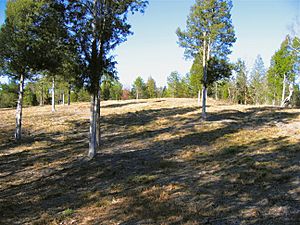Battle of Musgrove Mill facts for kids
Quick facts for kids Battle of Musgrove Mill |
|||||||
|---|---|---|---|---|---|---|---|
| Part of the American Revolutionary War | |||||||
 View towards the ridge line where Patriot militia defeated attacking Loyalist regulars and militia. |
|||||||
|
|||||||
| Belligerents | |||||||
| Commanders and leaders | |||||||
| Strength | |||||||
| 500 | 200 | ||||||
| Casualties and losses | |||||||
| 63 killed unknown number wounded 70 captured |
4 killed 12 wounded |
||||||
The Battle of Musgrove Mill happened on August 19, 1780. It took place near a river crossing called a ford on the Enoree River. This area is close to where Spartanburg, Laurens, and Union Counties meet in South Carolina today. In this battle, about 200 Patriot militiamen won against a larger force. This force included around 300 Loyalist militiamen and 200 regular soldiers.
Contents
Why They Fought: The Background
By the summer of 1780, the American Revolutionary War in South Carolina had become very intense. It was almost like a civil war. Many people fighting on both sides had never even seen Great Britain. The fighting in the backcountry areas was often very harsh. People on both sides wanted revenge for past actions.
The Battle Unfolds
On the evening of August 18, 1780, about 200 mounted Patriot soldiers got ready. They were led by Colonels Isaac Shelby, James Williams, and Elijah Clarke. Their plan was to surprise a Loyalist camp at Musgrove Mill. This mill was important because it controlled the local food supply. It also guarded a key crossing point on the Enoree River.
The Patriots thought they would find about the same number of Loyalists there. But a local farmer told them that the Loyalists had recently received help. About 100 more Loyalist militia and 200 regular soldiers had arrived. These new soldiers were on their way to join British Major Patrick Ferguson.
The Patriots knew their plan was no longer a secret. An enemy patrol had spotted them. Their horses were also too tired to keep going without rest. So, the Patriots realized they had to stand and fight. Even though they were outnumbered more than two to one, they prepared for battle. They quickly built a curved wall of brush and fallen trees. This wall was about 300 yards long. It was at the top of a ridge, looking down toward Musgrove Mill.
Clever Tactics and Fierce Fighting
The Patriots used smart guerrilla tactics. A small group of about 20 men, led by Captain Shadrach Inman, crossed the Enoree River. They pretended to be confused and then retreated. They led the Loyalists right back toward the Patriot ambush line. When the Loyalists saw the Patriot line, they fired their guns too early. The Patriots, however, waited. They held their fire until the Loyalists were very close. This meant their shots would be much more effective.
When the Patriots finally fired, their musket shots had a "devastating effect." Still, the Loyalist regular soldiers were well-trained. They almost broke through the Patriot right side with a bayonet charge. (Frontiersmen like the Patriots did not have bayonets.) Colonel Isaac Shelby quickly ordered his backup soldiers, known as the "Overmountain Men," to help. They rushed into the fight, shouting loud war cries. The Loyalists began to hesitate. When several of their officers were shot, they broke and ran. Sadly, Captain Inman, who played a big part in the Patriot plan, was killed during the battle.
The Patriots then ran from their positions, "yelling, shooting, and slashing." The entire battle lasted about an hour. In that short time, 63 Loyalists were killed. Many more were wounded, and 70 were captured. The Patriots had very few losses, with only about four dead and twelve wounded.
Who Fought Here?
Here are some of the groups who fought in the Battle of Musgrove Mill:
- Patriots (200 to 300 men):
- North Carolina and Georgia militia, led by Colonel Isaac Shelby:
- Sullivan County Regiment of North Carolina militia
- Burke County Regiment of North Carolina militia
- Washington County Regiment of North Carolina militia
- Wilkes County regiment of Georgia militia
- South Carolina militia, led by Colonel James Williams and Major Samuel Hammond:
- 1st Spartan regiment
- 2nd Spartan regiment
- Roebuck's Battalion of Spartan
- Lower District regiment
- Little River District regiment
- North Carolina and Georgia militia, led by Colonel Isaac Shelby:
- British and Loyalists (under Lt. Col. Alexander Innis):
- South Carolina Royalists (Loyalist soldiers trained like British Regulars)
- New Jersey Volunteers
- DeLancey's Brigade, 1st Battalion
- Fanning's South Carolina Loyalist militia
- Dutch Fork Regiment of Loyalist militia
What Happened Next?
After the battle, some Patriot leaders thought about attacking a Loyalist stronghold. This place was called Ninety Six, South Carolina. But they quickly scattered when they heard bad news. A large Patriot army had been badly defeated at Camden just three days earlier.
Shelby's forces traveled sixty miles with Major Ferguson chasing them. But they managed to escape safely. The victory at Musgrove Mill gave the Patriots hope. This was especially true after General Horatio Gates's big defeat at Camden. It showed that the Loyalists could not fully control the South Carolina backcountry.
Shelby and his Overmountain Men went back over the Appalachian Mountains. They returned to the Watauga Association area at Sycamore Shoals. This is in present-day Elizabethton, Tennessee. By September 25, 1780, Colonels Shelby, John Sevier, and Charles McDowell had gathered 600 Overmountain Men. They joined forces with Colonel William Campbell and his 400 Virginia men at Sycamore Shoals. This gathering was in preparation for the Battle of Kings Mountain on October 7, 1780. That battle happened near present-day Blacksburg, South Carolina.
The Musgrove Mill battlefield is now a preserved area. It is called the Musgrove Mill State Historic Site. It is also listed on the National Register of Historic Places.

